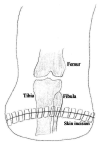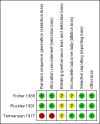Type of incision for below knee amputation
- PMID: 24715679
- PMCID: PMC7154343
- DOI: 10.1002/14651858.CD003749.pub3
Type of incision for below knee amputation
Abstract
Background: Below knee amputation (BKA) may be necessary in patients with advanced critical limb ischaemia or diabetic foot sepsis in whom no other treatment option is available. There is no consensus as to which surgical technique achieves the maximum rehabilitation potential. This is the third update of the review first published in 2004.
Objectives: To assess the effects of different types of incision on the outcome of BKA in people with lower limb ischaemia or diabetic foot sepsis, or both. The main focus of the review was to assess the relative merits of skew flap amputation versus the long posterior flap technique.
Search methods: For this update the Cochrane Peripheral Vascular Diseases Group Trials Search Co-ordinator (TSC) searched the Specialised Register (last searched 28 March 2013) and CENTRAL (2013, Issue 2).
Selection criteria: Randomised controlled trials comparing two or more types of skin incision for BKA were identified. People with lower limb ischaemia (acute or chronic) or diabetic foot sepsis, or both, were considered for inclusion. People undergoing below knee amputation for other conditions were excluded.
Data collection and analysis: One review author identified potential trials. Two review authors independently assessed trial quality and extracted the data. Additional information, if required, was sought from study authors.
Main results: Three studies with a combined total of 309 participants were included in the review. One study compared two-stage versus one-stage BKA; one study compared skew flaps BKA versus long posterior flap BKA; and one study compared sagittal flaps BKA versus long posterior flap BKA. Overall the quality of the evidence from these studies was moderate. BKA using skew flaps or sagittal flaps conferred no advantage over the well established long posterior flap technique (primary stump healing was 60% for both skew flaps and long posterior flap (risk ratio (RR) 1.00, 95% confidence interval (CI) 0.71 to 1.42) and primary stump healing was 58% for sagittal flaps and 55% for long posterior flap (Peto odds ratio (OR) 1.04, 95% CI 0.45 to 2.43). For participants with wet gangrene, a two-stage procedure with a guillotine amputation at the ankle followed by a definitive long posterior flap amputation led to better primary stump healing than a one-stage procedure (Peto OR 0.08, 95% CI 0.01 to 0.89). Post-operative infection rate or wound necrosis, reamputation, and mobility with a prosthetic limb were similar in the different comparisons.
Authors' conclusions: There is no evidence to show a benefit of one type of incision over another. However, in the presence of wet gangrene a two-stage procedure leads to better primary stump healing compared to a one-stage procedure. The choice of amputation technique can, therefore, be a matter of surgeon preference taking into account factors such as previous experience of a particular technique, the extent of non-viable tissue, and the location of pre-existing surgical scars.
Conflict of interest statement
None known
Figures
























Update of
-
Type of incision for below knee amputation.Cochrane Database Syst Rev. 2004;(1):CD003749. doi: 10.1002/14651858.CD003749.pub2. Cochrane Database Syst Rev. 2004. Update in: Cochrane Database Syst Rev. 2014 Apr 08;(4):CD003749. doi: 10.1002/14651858.CD003749.pub3. PMID: 14974033 Updated.
References
References to studies included in this review
Fisher 1988 {published data only}
-
- Fisher DF Jr, Clagett GP, Fry RE, Humble TH, Fry WJ. One‐stage versus two‐stage amputation for wet gangrene of the lower extremity: a randomized study. Journal of Vascular Surgery 1988;8(4):428‐33. - PubMed
Ruckley 1991 {published data only}
-
- Ruckley CV, Stonebridge PA, Prescott RJ. Skewflap versus long posterior flap in below‐knee amputations: multicenter trial. Journal of Vascular Surgery 1991;13(3):423‐7. - PubMed
Termansen 1977 {published data only}
-
- Termansen NB. Below‐knee amputation for ischaemic gangrene. Prospective, randomised comparison of a transverse and a sagittal operative technique. Acta Orthopaedica Scandinavica 1977;48(3):311‐6. - PubMed
Additional references
Alter 1978
-
- Alter AH, Moshein J, Elconin KB, Cohen MJ. Below‐knee amputation using the sagittal technique: a comparison with the coronal amputation. Clinical Orthopaedics and Related Research 1978;Mar‐Apr(131):195‐201. - PubMed
Burgess 1968a
-
- Burgess EM. The below‐knee amputation. Bulletin of Prosthetic Research 1968;5:19‐25.
Burgess 1968b
-
- Burgess EM. The stabilization of muscles in lower extremity amputations. Proceedings of the 81st annual meeting of the American Orthopaedic Association, 1968 Apr 22‐25; Boca Raton (Florida), Journal of Bone and Joint Surgery (American version) 1968;50A:1486‐7.
Catre 1997
-
- Catre MG, Lieberman IH. Laterally based skin flap for below‐knee amputation: case report. Journal of Trauma Injury Infection and Critical Care 1997;43(5):869‐71. - PubMed
Chavatzas 1975
-
- Chavatzas D, Budak D, Jamieson CW. An assessment of value of long posterior flaps in below knee amputation by skin blood pressure. Journal of Cardiovascular Surgery 1975;16(6):594‐6. - PubMed
Galvao 1975
-
- Galvao MS. An improved technique for below knee amputation. Journal of Cardiovascular Surgery 1975;16(6):603‐8. - PubMed
Haimovici 1996
-
- Haimovici H. Below‐the‐knee amputations. In: Haimovici H, Ascer E, Hollier LH, Strandness DE, Towne JB editor(s). Haimovici's Vascular Surgery. 4th Edition. Cambridge, Massachusetts: Blackwell Science, 1996:1333‐40.
Harrison 1987
-
- Harrison JD, Southworth S, Callum KG. Experience with the 'skew flap' below‐knee amputation. British Journal of Surgery 1987;74(10):930‐1. - PubMed
Higgins 2011
-
- Higgins JPT, Green S (editors). Cochrane Handbook for Systematic Reviews of Interventions Version 5.1.0 [updated March 2011]. The Cochrane Collaboration, 2011. Available from www.cochrane‐handbook.org.
Kaufman 1995
-
- Kaufman JL. Alternative methods for below‐knee amputation: reappraisal of the Kendrick procedure. Journal of the American College of Surgeons 1995;181(6):511‐6. - PubMed
McCullough 1981
-
- McCullough NC, Harris AR, Hampton FL. Below‐knee amputation. Atlas of limb prosthetics. St. Louis: CV Mosby, 1981.
Persson 1974
-
- Persson BM. Sagittal incision for below‐knee amputation in ischaemic gangrene. Journal of Bone and Joint Surgery (British volume) 1974;56(1):110‐4. - PubMed
Pinzur 1993
-
- Pinzur MS, Gottschalk F, Smith D, Shanfield S, Andrade R, Osterman H, et al. Functional outcome of below‐knee amputation in peripheral vascular insufficiency. A multicenter review. Clinical Orthopaedics and Related Research 1993;Jan(286):247‐9. - PubMed
Robinson 1976
Robinson 1982
-
- Robinson KP, Hoile R, Coddington T. Skew flap myoplastic below‐knee amputation: a preliminary report. British Journal of Surgery 1982;69(9):554‐7. - PubMed
Robinson 1991
Silbert 1950
-
- Silbert S, Haimovici H. Results of midleg amputations for gangrene in diabetics. Journal of the American Medical Association 1950;144:454. - PubMed
VSGBI 2010
-
- The Vascular Society of Great Britain and Ireland. Quality improvement framework for major amputation surgery. http://www.vascularsociety.org.uk/news‐and‐press/2010/47‐quality‐improve.... November 2010 (accessed July 2013).
VSSGBI 1996
-
- Anonymous. Recommendations for the management of chronic critical lower limb ischaemia. The Audit Committee of the Vascular Surgical Society of Great Britain and Ireland. European Journal of Vascular and Endovascular Surgery 1996;12(2):131‐5. - PubMed
Publication types
MeSH terms
Grants and funding
LinkOut - more resources
Full Text Sources
Other Literature Sources
Medical

